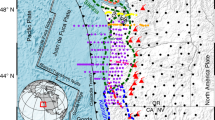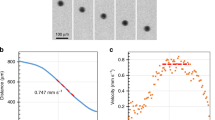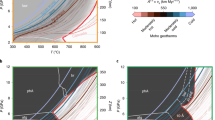Abstract
Soon after its creation, the upper part of the oceanic lithosphere becomes hydrated owing to prolonged interaction with sea water. As oceanic slabs sink into the mantle at subduction zones and experience increasing temperatures and pressures, they dehydrate and release fluids. Such slab fluids drive mantle melting and return ocean water to the Earth's surface through arc volcanism. The efficiency of this process, as well as the chemical make-up of slab fluids, depends on the pressure and temperature conditions experienced by the slabs as they subduct. A growing body of experimental data provides the basis for new geothermometers (for example the ratio of water to cerium) that, when combined with data from melt inclusions in volcanic crystals, predict that slab-fluid temperatures vary from 750 to 950 °C for different subduction zones. Such high values indicate that fluids that exit the slab when it is below the arc are likely to be like melts or solute-rich fluids. Slab surface temperatures inferred from these geothermometers are at the upper end of those predicted by thermal models, implying that fluids could be released at relatively shallow depths and efficiently returned to the surface.
This is a preview of subscription content, access via your institution
Access options
Subscribe to this journal
Receive 12 print issues and online access
$259.00 per year
only $21.58 per issue
Buy this article
- Purchase on Springer Link
- Instant access to full article PDF
Prices may be subject to local taxes which are calculated during checkout




Similar content being viewed by others
References
Hacker, B. H2O subduction beyond arcs. Geochem. Geophys. Geosys. 9, Q03001 (2008).
Manning C. E. The chemistry of subduction-zone fluids (frontiers). Earth Planet. Sci. Lett. 223, 1–16 (2004).
Schmidt, M. W., Vielzeuf, D. & Auzanneau, E. Melting and dissolution of subducting crust at high pressures: the key role of white mica. Earth Planet. Sci. Lett. 228, 65–84 (2004).
Hermann, J., Spandler, C., Hack, A. & Korsakov, A. V. Aqueous fluids and hydrous melts in high-pressure and ultra-high pressure rocks: Implications for element transfer in subduction zones. Lithos 92, 399–417 (2006).
Kessel, R., Ulmer, P., Pettke, T., Schmidt, M. W. & Thompson, A. B. The water-basalt system at 4 to 6GPa: Phase relations and second critical endpoint in a K-free eclogite at 700 to 1400 °C. Earth Planet. Sci. Lett. 237, 873–892 (2005).
Gill, J. Orogenic Andesites and Plate Tectonics (Springer, 1981).
Elliott, T. R. in Inside the Subduction Factory (ed. Eiler, J. M.) 23–45 (Geophysical Monograph Series Vol. 138, AGU, 2003).
Pearce, J. A., Stern, R. J., Bloomer, S. H. & Fryer, P. Geochemical mapping of the Mariana arc-basin system: Implications for the nature and distribution of subduction components. Geochem. Geophys. Geosys. 6, Q07006 (2005).
Grove, T. L., Parman, S. W., Bowring, S. A., Price, R. C. & Baker, M. B. The role of an H2O-rich fluid component in the generation of primitive basaltic andesites and andesites from the Mt. Shasta region, N California. Contrib. Mineral. Petr. 142, 375–396 (2002).
Eiler, J. M., Carr, M. J., Reagan, M. & Stolper, E. Oxygen isotope constraints on the sources of Central American arc lavas. Geochem. Geophys. Geosys. 6, Q07007 (2005).
Portnyagin, M., Hoernle, K., Plechov, P., Mironov, N. & Khubunaya S. Constraints on mantle melting and composition and nature of slab components in volcanic arcs from volatiles (H2O, S, Cl, F) and trace elements in melt inclusions from the Kamchatka Arc. Earth Planet. Sci. Lett. 255, 53–69 (2007).
McDade, P., Blundy, J. D. & Wood, B. J. Trace element partitioning between mantle wedge peridotite and hydrous MgO-rich melt. Am. Mineral. 88, 1825–1831 (2003).
Peacock, S. M., Rushmer, T. & Thompson, A. B. Partial melting of subducted oceanic crust. Earth Planet. Sci. Lett. 121, 227–244 (1994).
van Keken, P. E., Kiefer, B. & Peacock, S. M. High-resolution models of subduction zones: Implications for mineral dehydration reactions and the transport of water into the deep mantle. Geochem. Geophys. Geosys. 3, 1056 (2002).
Kelemen, P. B., Rilling, J. L., Parmentier, E. M., Mehl, L. & Hacker, B. R. in Inside the Subduction Factory (ed. Eiler, J. M.) 293–311 (Geophysical Monograph Series Vol. 138, AGU, 2003).
Arcay, D., Tric, E. & Doin, M.-P. Slab surface temperature in subduction zones: Influence of the interplate decoupling depth and upper plate thinning processes. Earth Planet. Sci. Lett. 255, 324–338 (2007).
Kincaid, C. & Griffiths, R. W. Variability in flow and temperature within mantle subduction zones. Geochem. Geophys. Geosys 5, Q06002 (2004).
Castro, A. & Gerya, T. V. Magmatic implications of mantle wedge plumes: Experimental study. Lithos 103, 138–148 (2008).
Peacock, S. M. in Inside the Subduction Factory (ed. Eiler, J. M.) 7–22 (Geophysical Monograph Series Vol. 138, AGU, 2003).
Rupke, L. H., Phillps Morgan, J., Hort, M. & Connolly, J. A. C. Serpentine and the subduction zone water cycle. Earth Planet. Sci. Lett. 223, 17–34 (2004).
Klimm, K., Blundy, J. D. & Green, T. H. Trace element partitioning and accessory phase saturation during H2O-saturated melting of basalt with implications for subduction zone chemical fluxes. J. Petrol. 49, 523–553 (2008).
Hermann, J. & Rubatto, D. Accessory phase control on the trace element signature of sediment melts in subduction zones. Chem. Geol. 265, 512–526 (2009).
Antignano, A. & Manning, C. E. Rutile solubility in H2O, H2O-SiO2, and H2O NaAlSi3O8 fluids at 0.7–20 GPa and 700–1000 °C: Implications for mobility of nominally insoluble elements. Chem. Geol. 255, 283–293 (2008).
Schmidt, M. W., Dardon, A., Chazot, G. & Vannucci, R. The dependence of Nb and Ta rutile-melt partitioning on melt composition and Nb/Ta fractionation during subduction processes. Earth Planet. Sci. Lett. 226, 415–432 (2004).
Hermann, J. & Spandler, C. J. Sediment melts at sub-arc depths: an experimental study. J. Petrol. 49, 717–740 (2008).
Manning, C. E. Fluid composition at the blueschist-eclogite transition in the model system Na2O-MgO-Al2O3-SiO2-H2O-HCl. Schweiz. Miner. Petrog. 78, 225–242 (1998).
Dixon, J. E., Leist, L., Langmuir, C. & Schilling, J.-G. Recycled dehydratrated lithosphere observed in plume-influenced mid-ocean-ridge basalt. Nature 420, 385–389 (2002).
Hauri, E. H., Gaetani, G. A. & Green, T. H. Partitioning of water during melting of the Earth's upper mantle at H2O-undersaturated conditions. Earth Planet. Sci. Lett. 248, 715 – 734 (2006).
Wallace, P. J. Volatiles in subduction zone magmas: concentrations and fluxes based on melt inclusion and volcanic gas data. J. Volcanol. Geotherm. Res. 140, 217–240 (2005).
Blundy, J., Cashman, K. & Humphreys, M. Magma heating by decompression-driven crystallization beneath andesite volcanoes. Nature 443, 76–80 (2006).
Gorbatov, A. & Kostoglodov, V. Maximum depth of seismicity and thermal parameter of the subducting slab: General empirical relation and its application. Tectonophysics 277, 165–187 (1997).
Syracuse, E. & Abers, G. Global compilation of variations in slab depthbeneath arc volcanoes and implications. Geochem. Geophys. Geosys. 7, Q05017 (2006).
Pardo, M. & Suarez, G. Shape of the subducted Rivera and Cocos plates in southern Mexico: Seismic and tectonic implications. J. Geophys. Res. 100, 12357–12373 (1995).
Cooper, L. Volatiles in Tonga Arc Magmas and Their Role in Unraveling Subduction Zone Processes. PhD thesis, Boston Univ. (2009).
Hirschmann, M. M. & Dasgupta, R. The H/C ratios of Earth's near-surface and deep reservoirs, and consequences for deep Earth volatile cycles. Chem. Geol. 262, 4–16 (2009).
Tropper, P., Manning, C. E. & Harlov, D. E. Solubility of CePO4 and YPO4 in H2O, H2O-NaCl, H2O-NaF and H2O-Albite Fluids at 800 °C and 1 GPa: Implications for REE transport during subduction-zone metasomatism. AGU Fall Meet. abstr. V31D–2184 (2008).
Kessel, R., Schmidt, M. W., Ulmer, P. & Pettke, T. Trace element signature of subduction-zone fluids, melts and supercritical liquids at 120–180 km depth. Nature 437, 724–727 (2005).
Montel, J.-M. A model for monazite/melt equilibrium and application to the generation of granitic magmas. Chem. Geol. 110, 127–146 (1993).
Cooper, L. et al. Boninites from the modern Tonga arc. J. Geophys. Res. (in the press).
Cervantes, P. & Wallace, P. J. Role of H2O in subduction-zone magmatism: new insights from melt inclusions in high-Mg basalts from central Mexico. Geology 31, 235–238 (2003).
Roberge, J., Delgado-Granados, H. & Wallace, P. J. Mafic magma recharge supplies high CO2 and SO2 gas fluxes from Popocatepetl volcano, Mexico. Geology 37, 107–110 (2009).
Acknowledgements
We are grateful to J. Hermann, P. Wallace and J. Roberge for unpublished data, and E. Syracuse for providing the thermal model in Fig. 4. We thank J. Hermann, M. Schmidt, P. Kelemen and E. Stolper for illuminating conversations, and J. Blundy, C. Spandler and D. Arcay for constructive reviews. This work is supported by the US National Science Foundation grants OCE-0526450 (T.P.) and EAR-0337170 (C.E.M.).
Author information
Authors and Affiliations
Contributions
T.P and C.E.M. developed the discussion of experimental data and slab fluid geothermometry models; L.B.C. assessed the arc melt inclusion data; T.P. took the lead in writing the paper, with substantial contributions from C.E.M. and L.B.C.
Corresponding author
Supplementary information
Supplementary Information
Supplementary Information (PDF 413 kb)
Rights and permissions
About this article
Cite this article
Plank, T., Cooper, L. & Manning, C. Emerging geothermometers for estimating slab surface temperatures. Nature Geosci 2, 611–615 (2009). https://doi.org/10.1038/ngeo614
Published:
Issue Date:
DOI: https://doi.org/10.1038/ngeo614
This article is cited by
-
Temporal variations in the diversity of primitive melts supplied to the Santorini silicic magmatic system and links to lithospheric stresses
Contributions to Mineralogy and Petrology (2022)
-
Tracking slab surface temperatures with electrical conductivity of glaucophane
Scientific Reports (2021)
-
Do Supercontinent-Superplume Cycles Control the Growth and Evolution of Continental Crust?
Journal of Earth Science (2020)
-
Stratigraphically controlled sampling captures the onset of highly fluid-fluxed melting at San Jorge volcano, Southern Volcanic Zone, Chile
Contributions to Mineralogy and Petrology (2019)
-
Near-solidus melts of MORB + 4 wt% H2O at 0.8–2.8 GPa applied to issues of subduction magmatism and continent formation
Contributions to Mineralogy and Petrology (2018)



